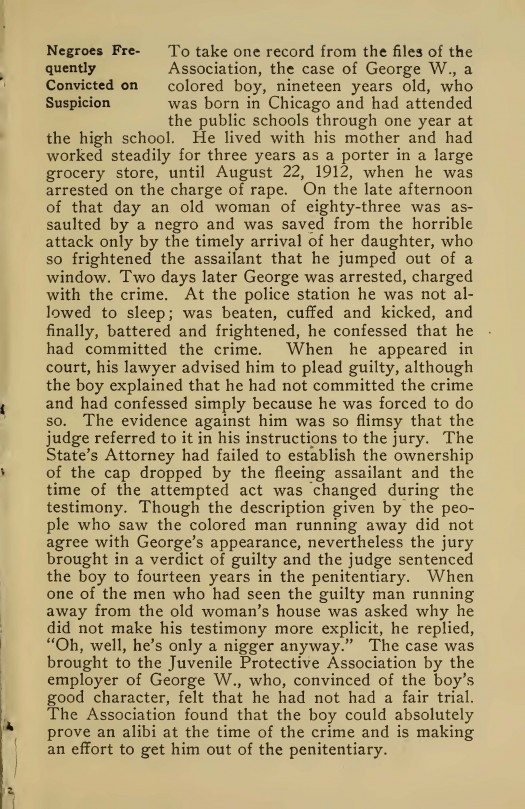1913 Chicago & 2011 Chicago:Black Youth Still Disproportionately Locked Up
“In the course of an investigation recently made by the Juvenile Protective Association of Chicago upon the conditions of boys in the County jail, the Association was much startled by the disproportionate number of colored boys and young men; for although the colored people of Chicago approximate 1/40 of the entire population, 1/8 of the boys and young men and nearly 1/3 of girls and young women who had been confined in the jail during the year were negroes.” – The Colored People of Chicago, 1913
So I spent all day yesterday at a forum that I organized along with my friend Cait to discuss the disproportionate impact of policing and incarceration on youth of color living on the Westside of Chicago. Interestingly as I was preparing for the forum, I came across a report written by the Juvenile Protective Association in 1913 titled “The Colored People of Chicago.” The passage quoted above comes from that report. I defy anyone to tell me that this very same paragraph could not be written in 2011 with respect to the disproportionate targeting by the criminal legal system of black youth in Chicago. The conversations that we were having yesterday at the Jane Addams Hull House Museum were probably the very same ones that animated reformers at the Museum in 1913 when the report that I am citing was published. The difference in 2011 is that the disproportionality of youth in the legal system is even more pronounced than in 1913 (if that can even be believed!).
Many of you might find the following passages from the 1913 report relevant to our current plight:
“From the interviews with all the boys in the jail it is clear that the lack of congenial and remunerative employment had been a determining factor in their tendency to criminality, but because the colored boys suffered under an additional handicap and because the opportunities for work are the essentials for all economic progress, the entire investigation had much to with the basic question of employment.”
“Those familiar with the police and the courts believe that negroes are often arrested on excuses to flimsy to hold a white man; that any negro who happens to be at the scene of a crime or disorder is promptly arrested and often convicted on evidence upon which a white man would be discharged. The Juvenile Protective Association has on record cases in which negroes have been arrested without sufficient cause and convicted on inadequate evidence, and it is well known that a certain type of policeman, juryman, and prosecuting attorney have apparently no scruples in sending “a nigger up the road” on mere suspicion. ”
“Occasionally, it happens that very little time is given to a case where a negro is concerned. Some time ago a colored man was arrested and charged with murder. He pleaded guilty and was sentenced by a judge to imprisonment for life in the penitentiary. It took just sixteen minutes from the time the negro was brought into the court to the time he left it, to have his case brought up, to plead guilty and to have a sentence of lifelong imprisonment pronounced. It surely seems as if such a serious crime as the taking of a life and the commitment of a man to prison for as long as he lives, should at least require less haste and more mature deliberation.”
The report also describes the case of a 19 year black man named George W to illustrate how the legal system in Chicago treated negroes at the time. I am attaching a PDF of the account HERE for those who might want a copy of it. The account that JPA provides is invaluable to helping us understand the context for young black males in Chicago in the early 20th century.
This is why I am so passionate about the teaching and learning of history. It is why I loved teaching social studies and why I have founded organizations that focus on making sure the leaders (youth and adults) of today understand social movement history. How can anyone read the report by JPA and not see the direct correlation with where we are in our current moment?
Read the entire report, it is well worth your time. Be advised that there are some cringe worthy aspects to the report especially when the authors suggest that colored people are “particularly fond of music.” Alas it was 1913 people, what do you expect????

